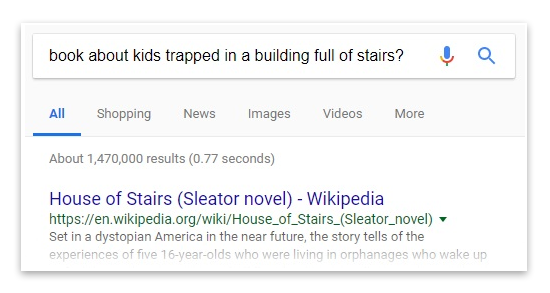
The Childhood Book that Scarred Me for Life
Lifelong readers often wax nostalgic when asked to recall beloved books from their formative years. These early reading discoveries can be positively magical. But many of us also have some darker memories associated with books that we read as kids.
When I was in sixth grade I read a terrifying book that scarred me for life, and I mean that literally. I think I was eleven. For decades I could not remember the name of that book nor how it ended. But I do remember that it COMPLETELY freaked me out. And the trauma lingered.
As an adult, all I really remembered was that there was a group of kids locked in a building with all these stairs, and the kids did awful, cruel things to each other. I also distinctly remember that the cover was as distressing as the book itself. It featured a creepy illustration of the teens involved in some bizarre dance among the stairs. Total nightmare fuel for life.
A few years ago, when this book came to mind yet again, it suddenly occurred to me that the internet was a thing, and I could probably find this mysterious and disturbing childhood book. In less than one second, Google delivered an answer. House of Stairs by William Sleator.

Clearly all the smarter traumatized children of the ’70s had retained this incredibly obvious title. Based on the comments I found online, I was not the only child to have been forever marked by the reading of this book.
Recently I was looking over the Read Harder Challenge, and I saw that one of the prompts was a book cover you hate. House of Stairs was the very first thing that came to mind. Again. And it got me thinking about this book that has haunted me for nearly forty years. I decided then and there that I was going to reread this book and see why it has such a hold on me. I went to the library, and there it was, nestled among several William Sleator books in the teen section.

The cover on the left is the one I remember from the ’70s. The equally hideous cover on the right is from the 1991 version that I recently checked out of the library.
(Warning: What follows is a tad spoilery, but I won’t give away the ending. If you like, feel free to go find this gem in your local library and read it before you continue.)
The story is basically what I remembered. Five orphaned teenagers are trapped, as the title suggests, in a giant house of stairs. The kids discover a red, glowing machine that distributes food, but only when they conform to certain behaviors. Their job is to figure out what the machine wants them to do, which turns out to be super unpleasant. Suffice it to say that this book is basically The Hunger Games of 1974, with the kids pitted against each other and experiencing all manner of trauma.
It was indeed just as alarming as I recalled. My eleven-year-old self had every reason to be freaked out. The stairs have no railings, so they could plummet to their deaths at any moment. The teens are half starved, no help is coming, and the cruelty mounts. The situation is seriously messed up, and answers don’t come until the very last few pages of the book.
But it certainly wasn’t the gut-punch I experienced as a kid. I was undoubtedly lacking the emotional maturity then to process what I read. Like most book nerds, I read early and above my grade level. I imagine I saw some cool teenager with it and decided I needed to read it too. I can picture myself back then, in my tube top and bell bottom jeans, library card in hand, proudly checking out this book that all the older kids had read. I am guessing that many other precocious readers had similar incidents.
I came across a fascinating article recently about early reading and how stories affect a child’s emotional development. In it, author Jennifer Miller points out that, “by grappling with dilemmas and difficult choices, we form our sense of what we believe is just and also, what defines the dark side.” Childhood reading allows us to mentally work through troubling issues in a safe environment, preparing us to deal with complex issues later on in real life. Reading House of Stairs was definitely a part of that process for me.
Reading challenged me and helped me to understand myself. I found out what I truly cared about, what I loved, and what made me mad. Reading House of Stairs helped cement some core beliefs in my young mind that are still bedrock values for me today: that all people have inherent value no matter what their background, and that violence and cruelty are never an acceptable answer to any problem. I also discovered that, both in books and in life, I feel the pain of others deeply, sometimes too much.
That book I read as a child, along with so many others, shaped the adult I am today. So I guess that terrifying childhood book did indeed scar me for life. And maybe that’s not a bad thing after all.











